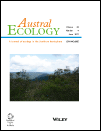Ver ítem
- xmlui.general.dspace_homeCentros Regionales y EEAsCentro Regional Entre RíosEEA Concepción del UruguayArtículos científicosxmlui.ArtifactBrowser.ItemViewer.trail
- Inicio
- Centros Regionales y EEAs
- Centro Regional Entre Ríos
- EEA Concepción del Uruguay
- Artículos científicos
- Ver ítem
A fungal endophyte of a palatable grass affects preference of large herbivores
Resumen
Temperate grasses frequently acquire resistance to herbivores through a symbiosis with epichloid fungi that produces alkaloids of variable deterrent effects. However, in those cases without apparent endophyte negative effects on domestic herbivores, it is not clear whether plant consumption or preference is affected or not. We performed three experiments with 1‐year‐old steers (Bos taurus, Aberdeen Angus) and the annual grass Lolium multiflorum, infected
[ver mas...]
Temperate grasses frequently acquire resistance to herbivores through a symbiosis with epichloid fungi that produces alkaloids of variable deterrent effects. However, in those cases without apparent endophyte negative effects on domestic herbivores, it is not clear whether plant consumption or preference is affected or not. We performed three experiments with 1‐year‐old steers (Bos taurus, Aberdeen Angus) and the annual grass Lolium multiflorum, infected or not by Epichloë occultans to evaluate preference and to identify the underlying tolerance mechanisms. The first experiment evaluated steer preference for L. multiflorum cultivated in plots with three endophyte infection frequencies (low, medium and high), and investigated the role of canopy structure and plant nutritional traits on preference. The second experiment evaluated preference for chopped grass, offered in individual trays with contrasting infection frequencies (low and high), to discard possible effects associated with canopy structure and to focus on nutritional traits. The third experiment was performed with a tray + basket design that separated visual and olfactory stimuli from nutritional traits. High endophyte infection frequencies reduced consistently animal preference, even after short (~10 min) feeding events. However, we did not find significant evidence of plant structural, nutritional, visual or olfactory traits. Our results discarded several potential mechanisms; therefore, the dissuasive effect of fungal endophytes on animal consumption might be related to other mechanisms, including, likely, alkaloids and changes on grass metabolome.
[Cerrar]

Autor
Hernández Agramonte, Ignacio M.;
Semmartin, María Gisela;
Omacini, Marina;
Durante, Martin;
Gundel, Pedro Emilio;
De Battista, Jose Pedro;
Fuente
Austral Ecology 43 (2) : 172-179 (April 2018)
Fecha
2018-04
ISSN
1442-9985
1442-9993
1442-9993
Formato
pdf
Tipo de documento
artículo
Palabras Claves
Derechos de acceso
Restringido
 Excepto donde se diga explicitamente, este item se publica bajo la siguiente descripción: Creative Commons Attribution-NonCommercial-ShareAlike 2.5 Unported (CC BY-NC-SA 2.5)
Excepto donde se diga explicitamente, este item se publica bajo la siguiente descripción: Creative Commons Attribution-NonCommercial-ShareAlike 2.5 Unported (CC BY-NC-SA 2.5)

